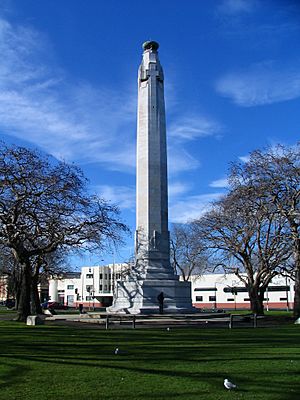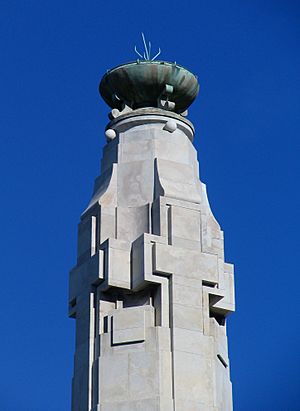Dunedin Cenotaph facts for kids
The Cenotaph in Dunedin, a city in southern New Zealand, is a special monument. It stands in the middle of Queen's Gardens, which is very close to the city centre. This monument is Dunedin's main war memorial, built to remember soldiers who fought for their country.
Contents
Where is the Cenotaph?
The Cenotaph is located in Queen's Gardens, an open park area. This park is found between a busy part of the city called The Exchange and the Toitū Otago Settlers Museum. It's about 400 metres (or 437 yards) south of the very centre of Dunedin, known as The Octagon. Busy one-way streets, which are part of State Highway 1, run along the east and west sides of the gardens.
What does it remember?
The monument honours people from Dunedin who served in New Zealand's armed forces and died during the First and Second World Wars. Near the Cenotaph, there's another plaque. This plaque lists the names of all New Zealanders who have received the Victoria Cross, which is a very brave award. Some trees around Queen's Gardens were planted to mark important war anniversaries, and they have plaques too. The nearby Toitū Otago Settlers Museum also has a section about New Zealand's role in the two world wars.
How was the Cenotaph built?
The design for the Cenotaph was chosen from 63 different ideas in a public competition. The winning design came from William Gummer, an architect from Auckland. He also designed other memorials, like the Bridge of Remembrance in Christchurch.
What is it made of?
The monument is built from concrete, but it's covered with beautiful Carrara marble. William Gummer designed it as an eight-sided column, about 28 metres (92 feet) tall. This eight-sided shape was chosen because it matches Dunedin's city centre, which is also octagonal. At the very top of the column is a symbolic beacon, like a light. From the main column, there's a special urn and four crosses, which represent sacrifice. These parts, along with a detailed carving at the base showing a lion, torches, and laurel wreaths, were designed by a sculptor named Richard Oliver Gross.
When was it opened?
The first stone of the Cenotaph was laid in 1924 by Dunedin's mayor, Harold Livingstone Tapley. Inside a special capsule under the stone, they placed old documents about the military in the Otago region and copies of newspapers from that time. The finished memorial was officially opened on March 17, 1927. Prince Albert, who later became King George VI, unveiled it. About 1,000 family members of those who had died and 800 returned soldiers attended the ceremony, along with many other people.
It was first called "The Citizens' Memorial." But soon, people started calling it "The Cenotaph." This name is similar to a famous monument in London, even though Dunedin's Cenotaph isn't exactly an "empty tomb" design, which is what a cenotaph usually means. After the Second World War ended, a plaque was added to the memorial to remember those who died in that conflict.
How is the Cenotaph used today?
The Cenotaph is the main place in Dunedin for Anzac Day ceremonies. These events happen every year on April 25th and often attract thousands of people. On Anzac Day in 2015, which was 100 years after the original Anzac landings, a huge crowd of almost 20,000 people came to the dawn service at the Cenotaph.
The Cenotaph is also recognised as an important historical site. It has a Category II classification from Heritage New Zealand. After the big 2011 Christchurch earthquake, many buildings and monuments in New Zealand were checked for safety. Experts looked at the Cenotaph and suggested ways to make its structure stronger. The Dunedin City Council plans to do this work and also look at other ways to improve the Queen's Gardens area.



